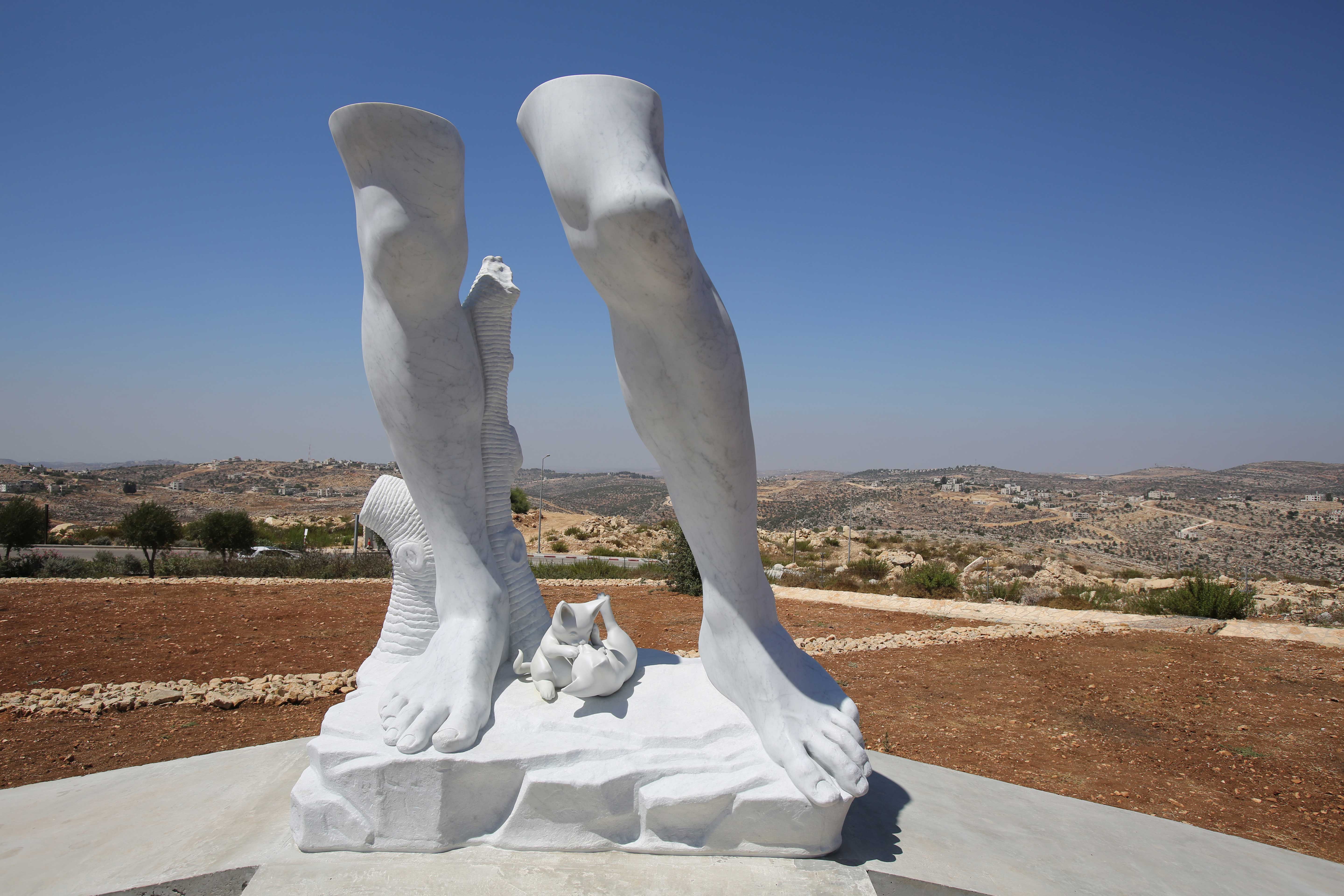
"The Theater of Disappearance", 2017
Carrara marble and nylon 12 PA, dimensions variable.
Adrián Villar Rojas: Born 1980, Rosario, Argentina. Lives and works between Rosario and New York.
Adrián Villar Rojas has executed memorable and monumental installations and sculptures that deal with ideas around the future, the age of human impact and decay. These monolithic forms and otherworldly creatures are suspended in an ambiguous time, like futuristic fossils from an unanchored past and an imagined place. Produced in clay, concrete, earth, pigments, fossils or plastic, his works reveal nature as it is influenced by human invention. In "The Theater of Disappearance", an ongoing project that Villar Rojas has produced in different iterations around the world, architectural forms resembling sloping wall-like ramps lead up to truncated legs made in Carrara marble that reference David, the hero who defeated Goliath with a stone. The specific reference to Michelangelo’s David is immediately recognisable through the tree stump that buttresses the original marble statue. The legs are a one-to-one cast of the legs of Michelangelo’s figure. They stand steadfast, cut from the rest of the body and transplanted in the centre of four cement slabs. David is here transplanted to the land of the original story – but, always allowing for a level of play, Villar Rojas also adds two kittens playfully kissing at the base of the feet.
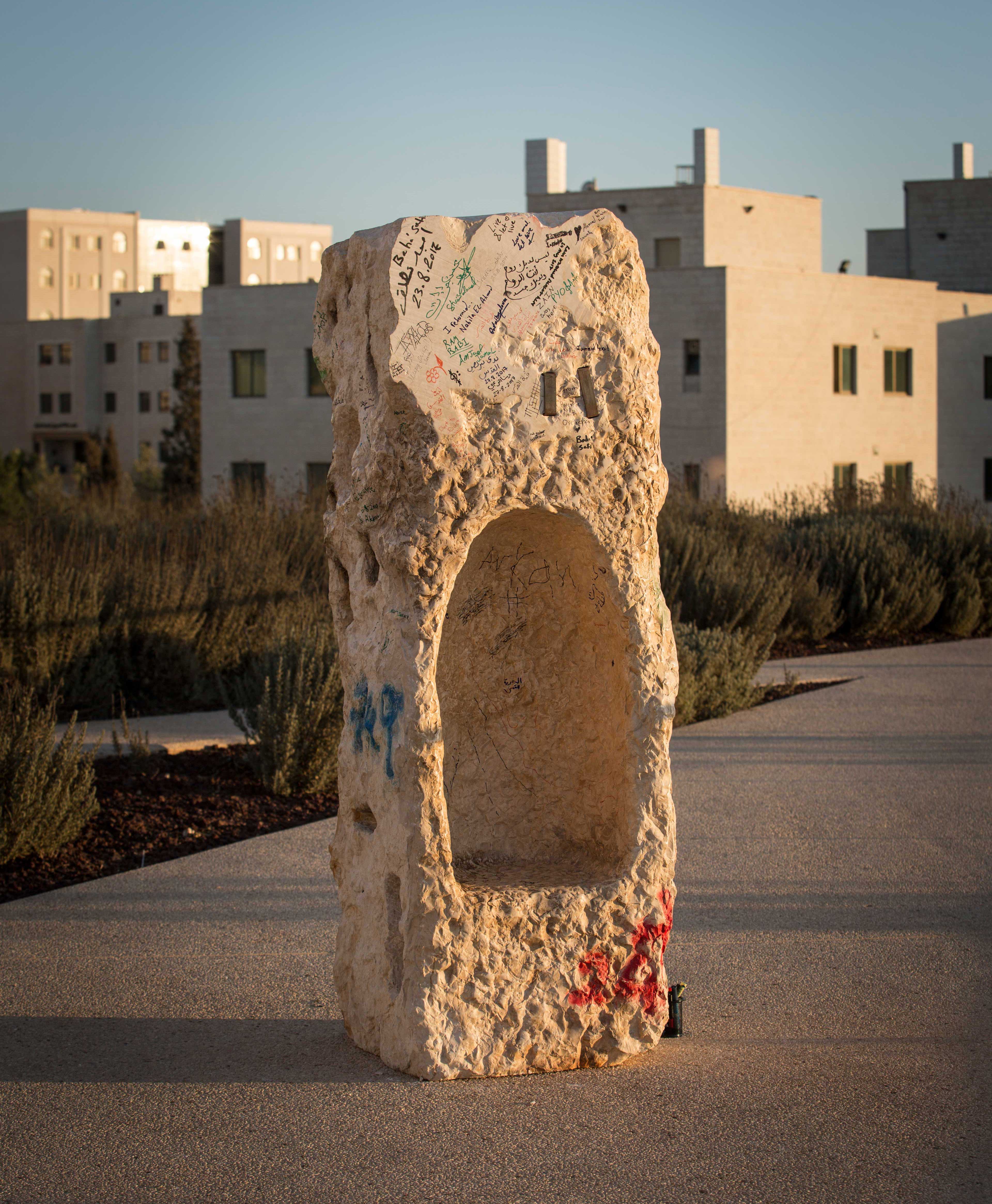
"Stone - Opus 15", 2017
Palestinian stone, 200x70x70 cm.
Athar Jaber: Born 1982, Rome, Italy. Lives and works in Antwerp, Belgium.
Athar Jaber’s figure sculptures, primarily produced in stone, focus on degradation, violence, fragility and questions of beauty. Born to Iraqi parents, his sculptures reflect on violence and war and their effects on real bodies. Raised in Florence, the artist questions, by creating deformed figures, the tradition of depicting perfection and beauty in marble statues. Jaber subjects his marble sculptures to carving, sandblasting, acid, and even shooting the faceless stone busts, limbs and figures. The materiality of the degraded surfaces force an emotional reaction to an otherwise cold stone body. "Stone - Opus 15" is the outcome of the artist’s extensive travels to Jerusalem, Jericho and Bethlehem. Working onsite at the Palestinian Museum, Jaber considers the city of Jerusalem, a city defined by stones whose surfaces are sanctified and violated, worshipped and neglected all at once. He has carved various body parts in negative relief as gaps in the stone – a head, a shoulder, a hand – inviting visitors to touch and become one with the stone.
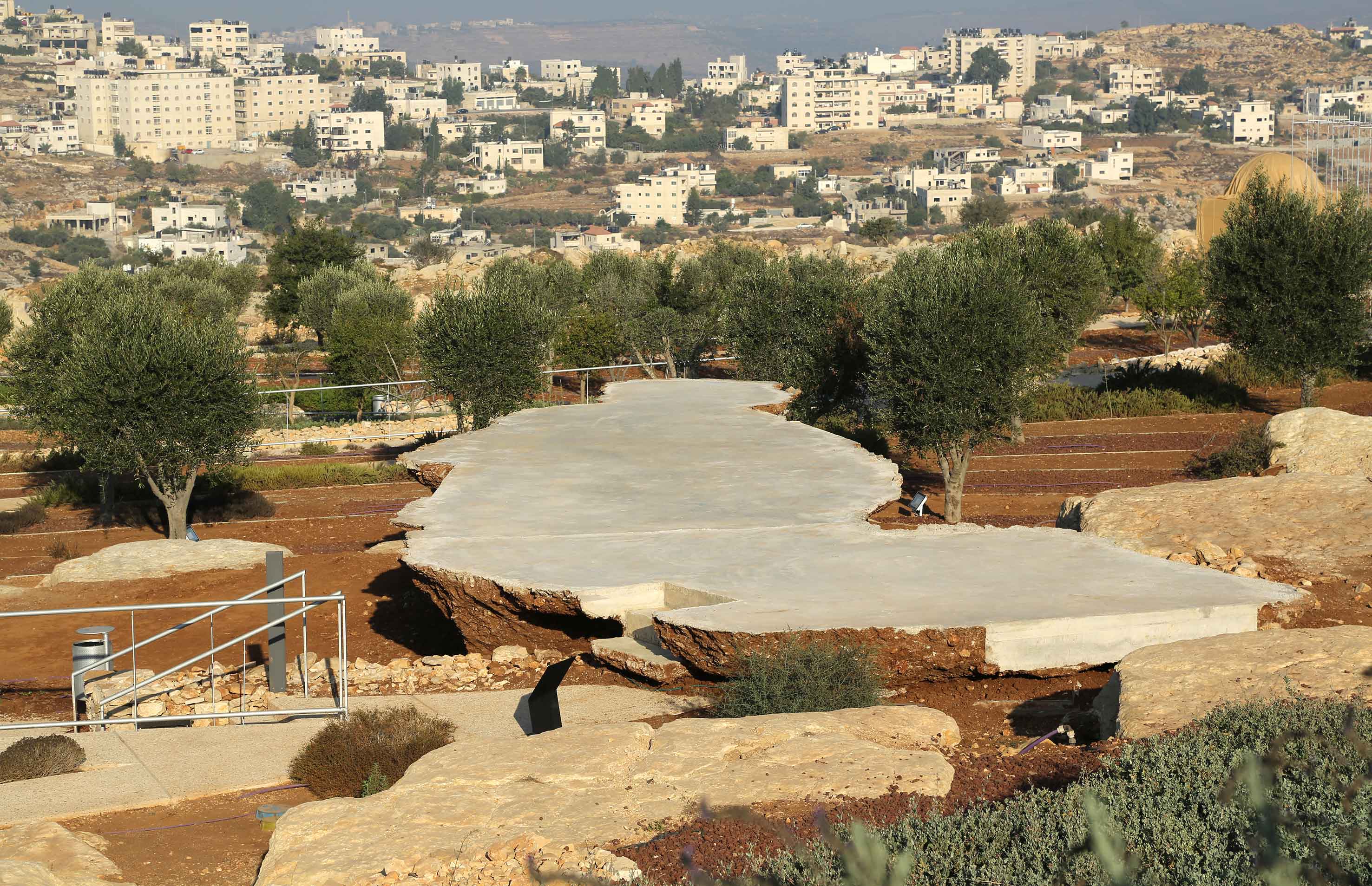
"Acts on the ground, OI#17241", 2017
Concrete, steel reinforcement, soil, 1850x 800x200 cm.
Bob Gramsma: Born 1963, Uster, Switzerland. Lives in Zürich.
Bob Gramsma’s installations and sculptural interventions are concerned with finding spatiality in nature and the outdoors, often taking the form of monumental sculptures that are forms of holes excavated from the earth. His interventions are both coincidental and concise as he rearranges existing elements in nature or introduces foreign materials to a natural environment, searching for form. facts on the ground, "OI#17241" is a site-specific earthwork made from negative space. The artist has created a mound and then dug into it, only to fill it with concrete, making a cast of the cavity. The outcome is a sculpture, partially raised from the earth and appropriately in line with the horizon and sunset. The slanted slab of concrete located in the Palestinian Museum’s ‘Garden of Resistance’ unintentionally mimics the blocks of cascading stone adjacent to it, but also looks as foreign as a sinking wall, submerging and becoming horizontal with the earth. The title suggests a plain view of what is happening “on the ground”, bringing to mind industry and war, the real-estate boom happening throughout the West Bank and Gaza, and roadblocks on the streets. Visitors are welcome to walk on the sculpture.
"Untitled (servees)", Jerusalem 2008
Emily Jacir: Born 1972, Bethlehem, Palestine. Lives and works in Bethlehem and Rome.
"Untitled (servees)" is a site-specific sound installation originally created for Damascus Gate (Bab il Amoud), which stands at the start of the road leading from Jerusalem to Nablus and onward to Damascus. Once a large hub of the main regional transport network of communal taxis, there used to be direct links to Beirut, Amman, Baghdad or Kuwait, as well as every urban Palestinian centre such as Lyd, Jaffa, Ramallah, Nablus, Gaza or Ramle. Damascus Gate was the point where servees drivers would pick up customers by calling out the names of their various destinations. "Untitled (servees)" recalls this and the once fluid space of movement, connection and exchange, and makes visible the fractures and interactions of everyday life within the disintegrating urban landscape. Calling out the names of these cities, the servees drivers recall their destinations.
This audio work is part of an ongoing long-term research which explores and investigates the disappearing transportation network in Palestine and its implications on the physical and social experience of space, a result of the fragmentation and continued destruction of the urban landscape by the Israeli Occupation.
Originally commissioned by Al-Ma’mal Foundation, Jerusalem, it has been readapted here for the Museum parking lot.

"Compass", 2017
Telescope, ceramic, dimensions variable.
Khaled Hourani: Born 1965, Hebron, Palestine. Lives and works in Ramallah.
Khaled Hourani’s experimental and conceptual artistic practice is a synthesis of daily life, work, culture and art. An artist, writer and curator, and co-founder and previous Artistic Director of the International Academy of Art Palestine, he has instigated and created projects that reveal the political and military interferences with the day-to-day in occupied Palestine. Hourani’s paintings, photographs and sculptures borrow from culture as brought about by politics, focusing primarily on narrative and the spoken word. "Compass" consists of a telescope placed on the Museum’s terrace, like those found in lookout points throughout the world. Visitors are encouraged to use it to look for a blue decorative ceramic plate adorned with the well-known phrase of the poet Muthafar Al Nawab “A compass does not lead to Jerusalem...”, that has been placed in the nearby village of Kobar. The viewer is also given the freedom to look beyond the horizon, at what can and cannot be seen of the land around us. Here, Hourani considers the idea of farsightedness as a mechanism to move beyond the limitation of material experience, and to look beyond the closure.
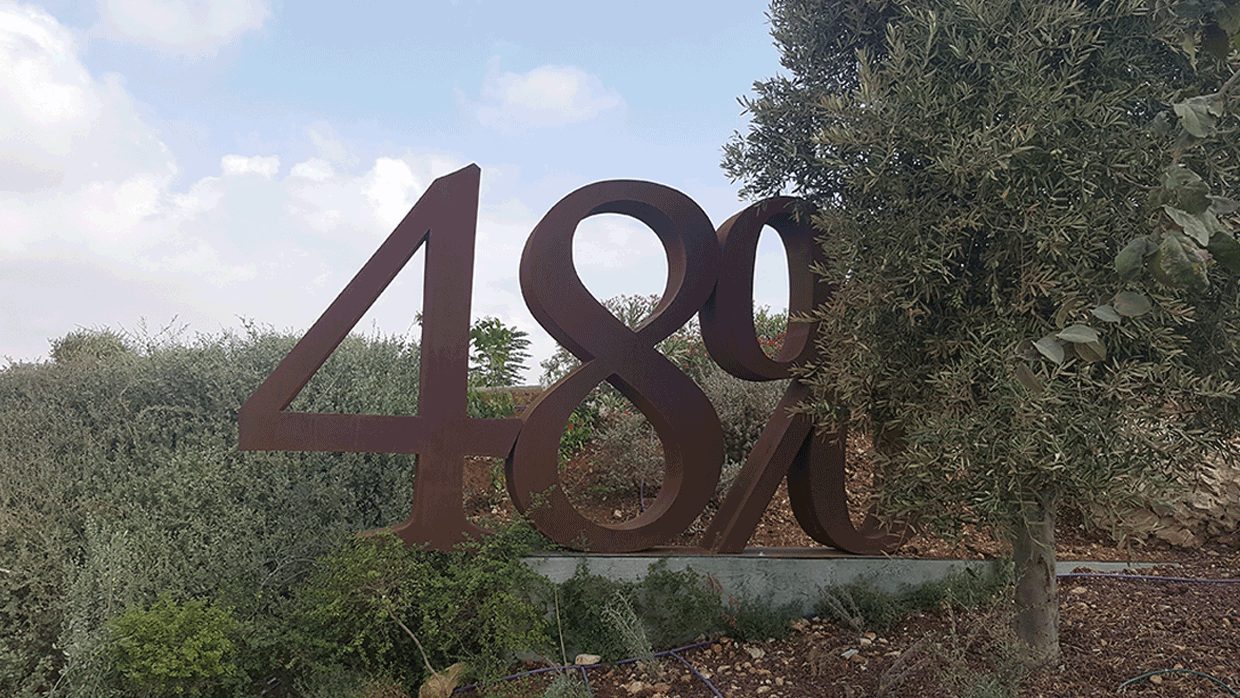
"48%, 67%", detail from "Palestine after Palestine New Sites for the Museum Department", 2017
Steel, dimensions variable.
Khalil Rabah: Born 1961, Jerusalem, Palestine. Lives and works in Ramallah and Beirut.
Khalil Rabah blurs the boundaries between art and institutional infrastructures through his conceptual artworks and long-term projects that explore how history, identity and culture are constructed. He often assumes the role of artist, producer and director, which he performs through his ongoing presentations of The Palestinian Museum of Natural History and Humankind (2003–ongoing) or the Riwaq Biennale (2005–ongoing), with their considerations of the site of the cultural institution as both medium and work of art. "48%" and "67%" can be considered a detail from Rabah’s work, Palestine after Palestine New Sites for the Museum Department". These larger than life-sized rusting steel sculptures emerge from the ground as though they had just been excavated. They appear as ruins, decaying and archaic, purposefully lying amongst the shrubbery. The numbers ‘48’ and ‘67’ delineate important time markers in Palestinian history, referring as they do to the wars of the Nakba and Naksa that have long defined the Palestinian reality. The artist adds the percentage sign (%) to allude to what has been lost of the land. 1948 references the percentage of the land that has been lost, with more lost in 1967, etc. While 2017 marks the 50th anniversary of the 1967 war, the percentage sign prompts us to ask how we can imagine a Palestine that exists beyond these numbers to reclaim independence and resist being defined by more material loss and disaster.

"Directions (Border)", 2017
Vinyl on glass, dimensions variable.
Mohamed Kazem: Born 1969, Dubai, The United Arab Emirates. Lives and works in Dubai.
Mohammed Kazem is one of the leading conceptual artists in the United Arab Emirates. His performances, immersive installations and actions capture the poetics of belonging, place and change. His ongoing project, "Directions", began in 1999 and continues through works that examine changes in the social and physical world. While on a fishing trip, Kazem fell overboard and was lost at sea for over half an hour before being rescued through the use of GPS. This experience inspired his work with GPS coordinates, which he sets in motion via water, wind or sunlight. "Directions (Border)" stems from this line of inquiry and is a site-specific piece installed in vinyl on the facade of the Museum’s glass gallery. It explores traversal and anchoring, and the desire to cross borders and barriers. The GPS coordinates mark the glass and cast reflections of shadows and light. They reference cities Kazem is prohibited from visiting, including Jerusalem, Beirut and Damascus, and question notions of traversing and survival, while reflecting on Jerusalem, a city that is also being denied to the world. His is a predicament of the Arab citizen in the 21st century, but through his art and light there is a momentary union and material coexistence.

"KA (Oslo)", 2009/2017
2 JCB 3CX 1993-model backhoe arms, 600x400x100 cm.
Nida Sinnokrot: Born 1971, Pittsburgh, United States of America. Lives and works in Jerusalem.
Nida Sinnokrot is an artist and filmmaker. He is interested in the way meaning is formed in conjunction with the mechanics and politics of technology and narrative structures. The artist aims to bring to the surface these various technologies of control, to celebrate multiplicity of voices and to challenge those systems that continue to give rise to shifting social, political and geographic instabilities. "Ka (Oslo)" is among the works in "Jerusalem Lives" that respond directly to the land. The first iteration of Ka was made for the 2009 Sharjah Biennial, but it is reimagined for ‘Jerusalem Lives’ using much larger JCB 3CX arms from 1993. The contemporary history of Palestine, post-Oslo, can be deciphered in their scarred, beaten and repaired surface. Installed on the Museum’s terrace, they are balanced upside down with their two arms raised up to the skies in a primal gesture that recalls despair as well as prayer, absolution and defiance. As these machines are the same ones used for both building and demolishing homes in Palestine, "Ka (Oslo)" also points to issues of power and agency "Ka" is an ancient Egyptian hieroglyph symbolising the life force, both destructive and creative. In what seems like daunting, and irreversible, material realities in the Palestinian context, the artist thus draws possibilities for reversal and change.
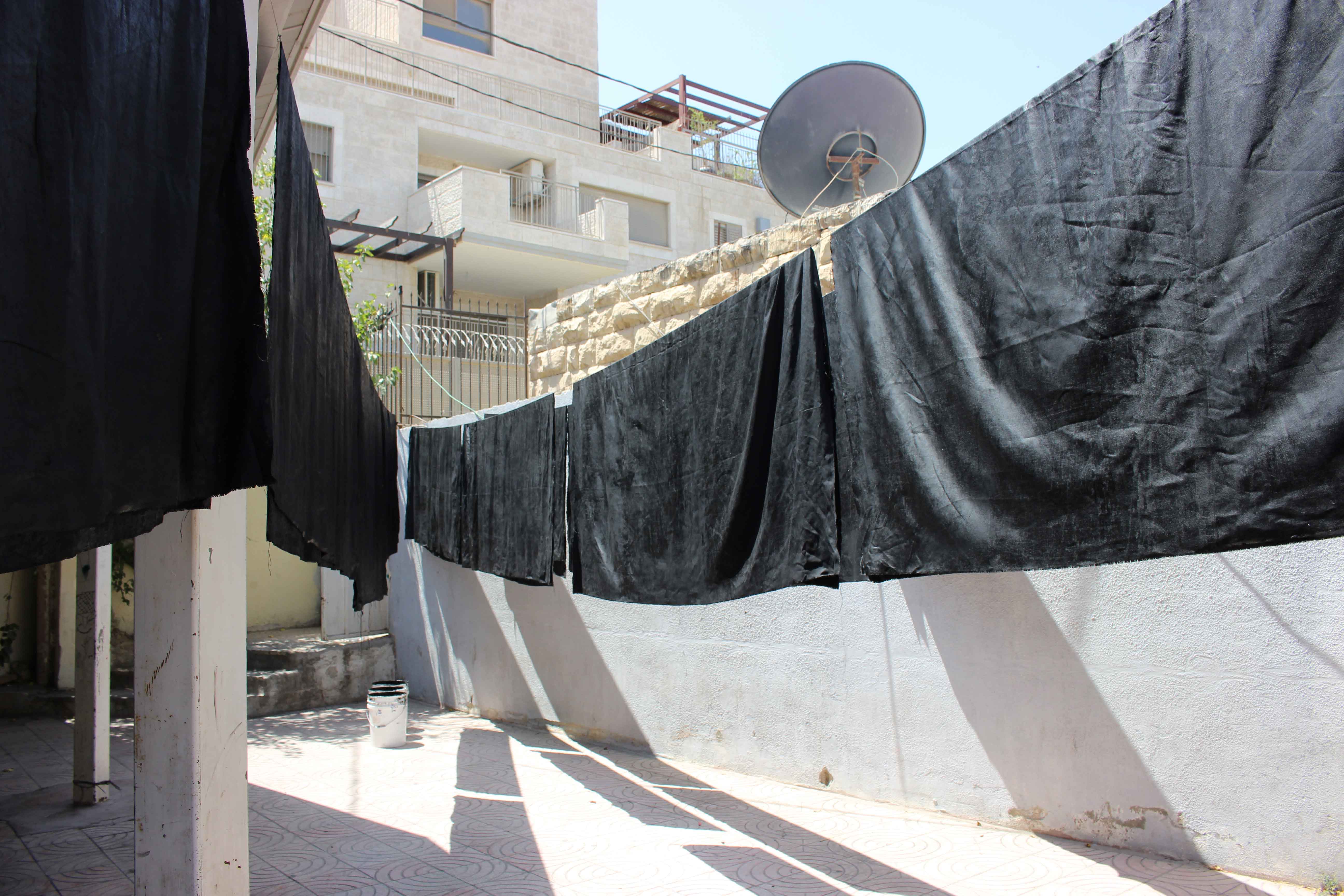
"the institute of reconciliation", 2012–ongoing
Mixed media installation, dimensions variable.
Oscar Murillo: Born 1986, Valle del Cauca Department, Colombia. Lives and works in London.
Oscar Murillo employs the medium of painting in unconventional and new ways to also combine elements of drawing, video, sculpture, installation and performance. His works are visceral and intense: to walk into one of his installations is to be immediately confronted with the pungent scent of his materials, whether oil paint, dirt, dust or other debris. The series he refers to as the black paintings, created with family members and close-knit communities, stand in opposition to the contemplative, rigid displays of the traditional white canvases. The heavy, sewn and torn black canvases, painted with black oil paint, make up sprawling installations that hang on lines or drape on steel. The installations push the boundaries of how paintings are displayed, handled or considered. They reflect on histories of labour, trade, community, consumption and art. For "the institute of reconciliation", Murillo shipped canvas and black oil paints to Palestine and established collaborations with cultural institutions in Jerusalem, such as the Silwan Club and the African Community Center, thus initiating the Jerusalem branch of this ongoing project.

"Threshold of Being", 2017
Galvanised steel, Jerusalem stone, timber, 1200x300x500 cm.
Rain Wu and Eric Chen: Born 1987 and 1978 in Tainan and Taiwan. Both live and work in London and Taichung.
Rain Wu is an architect whose practice extends across art and design to include installation, drawing, curating, set and building design. Wu’s architectural training informs her artistic practice, and her collaborations with Eric Chen, a scholar and principal architect of ArchiBlur Lab, include projects that consider the connections between bodies and controlled landscapes, and how the organic functions within order. For the 2017 Sharjah Biennial 13, they produced Collectivism, an installation constructed out of 700 bulletproof shields. The structure wrapped around a garden that visitors could walk into, and referenced Taiwan’s recent civil protest movements and the conflict between the individual and the institutional. "Threshold of Being" is an elevated structure that appears as a wall or bridge rising between two rows of olive trees at the end of the Palestinian Museum’s gardens. Constructed out of galvanised steel and Jerusalem stone, the structure is walled off, almost imprisoned, indicating both access and separation. This is especially relevant today, with the walls and gates that are erected as physical barriers, separating people, obstructing the continuity of land and cementing division as the new norm.

"We know what it is for/we who have used it", 2017
Four 3D-printed marble masks, 5 channel sound installation, dimensions variable.
Basel Abbas and Ruanne Abou-Rahme. Born 1983, Nicosia (Cyprus) and Boston (United States of America). Both live and work in Ramallah and New York.
Basel Abbas and Ruanne Abou-Rahme collaborate on research-based artistic projects that investigate the present moment, and its stagnation, to uncover new political narratives that focus on agency. "We know what it is for/we who have used it" is part of a long-term and multi-part project, presented here as an installation composed of 3D-printed masks in marble with accompanying sound composed by the artists. Abbas and Abou-Rahme have focused on 13 Neolithic masks, dated to 9,000 years old and the oldest known masks, mostly looted from the West Bank and now in private collections. In 2014, the Israel Museum in Jerusalem mounted a substantial exhibition around these masks that instrumentalised them by linking them to the nationalistic narrative of the ancient and contemporary ‘Land of Israel’. The artists hacked the designs of the masks using the exhibition site of the Israel Museum to make 3D designs of each mask, allowing them to reproduce and circulate multiple copies of the masks in a range of materials from marble as shown here to black plastic and sandstone. In juxtaposition, the sound element of the work they have created narrates the stories of these masks and their unexpected connection to the destroyed Palestinian villages, such as Suba on the outskirts of Jerusalem, whose people are forgotten and dismissed. Abbas and Abou-Rahme free the masks from these didactic constraints to reclaim them as freestanding critical agents that demand equity for the living.
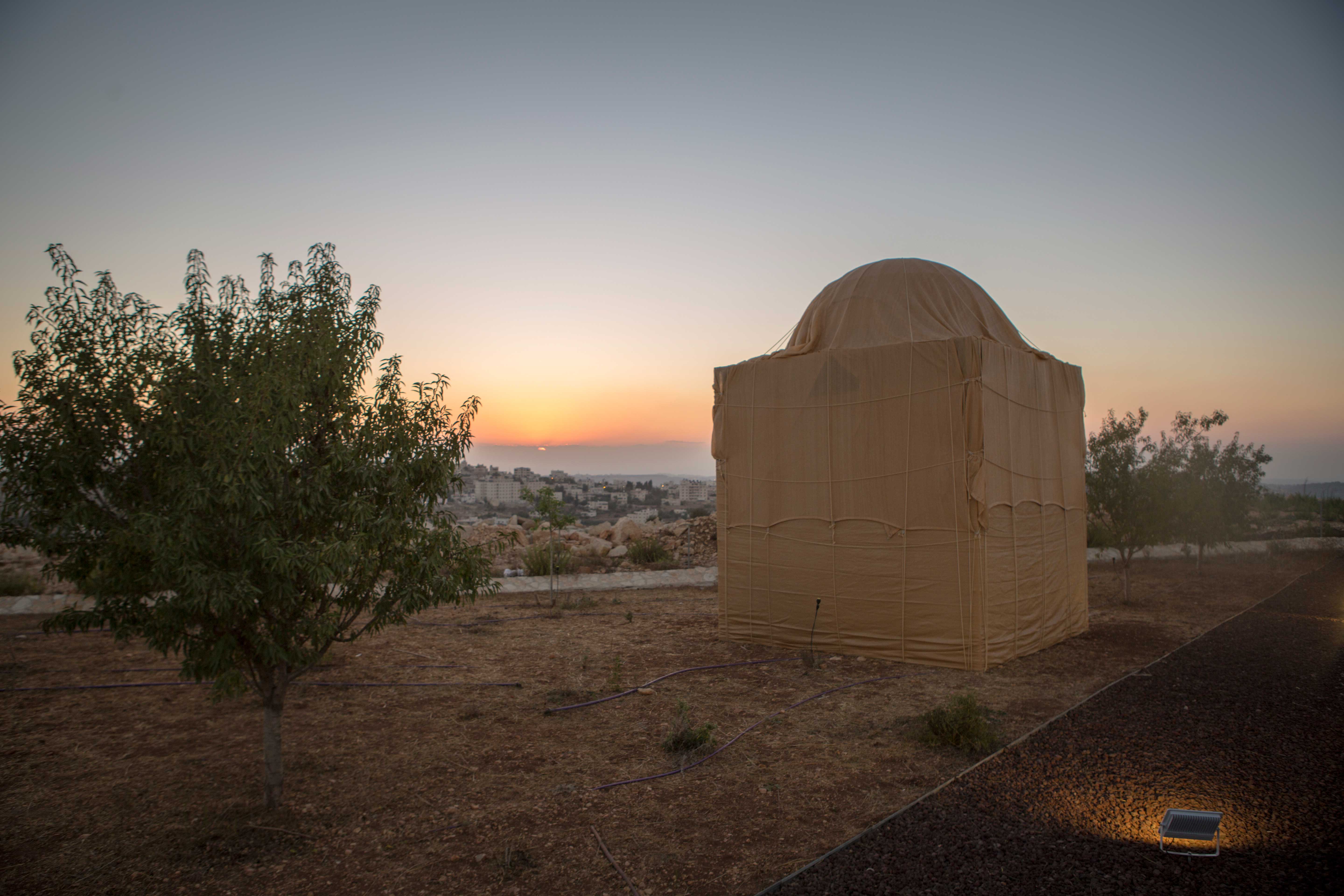
"Key of Return", 2017
Wood, tarpaulin, dimensions variable.
Sudarshan Shetty: Born 1961, Mangalore, India. Lives and works in Mumbai.
Sudarshan Shetty creates sculptures and installations using recycled wood from houses undergoing renovation and discarded furniture with missing legs or arms that he mends with other materials in order to complicate assumptions of what is and is not considered functional or valuable. His works deal with themes around the politics of material absence or loss, of death and the displacement of things. Recent bodies of work have focused on tombs and abandoned structures of worship. "Key of Return" is a five-metre high architectural structure with a dome, shrouded in sandy, taupe-coloured tarpaulin, giving it the appearance of a sacred and meditative space that cannot be entered. At the same time, the wrapping of the object gives it a transitory nature and suggests abandoned belongings, or things put in storage and awaiting someone’s return. The structure holds several references to Palestine, from the old stone sheds that were forcibly abandoned, to sites now devoid of their caretakers, lifeless but still lingering on until their owners come back.
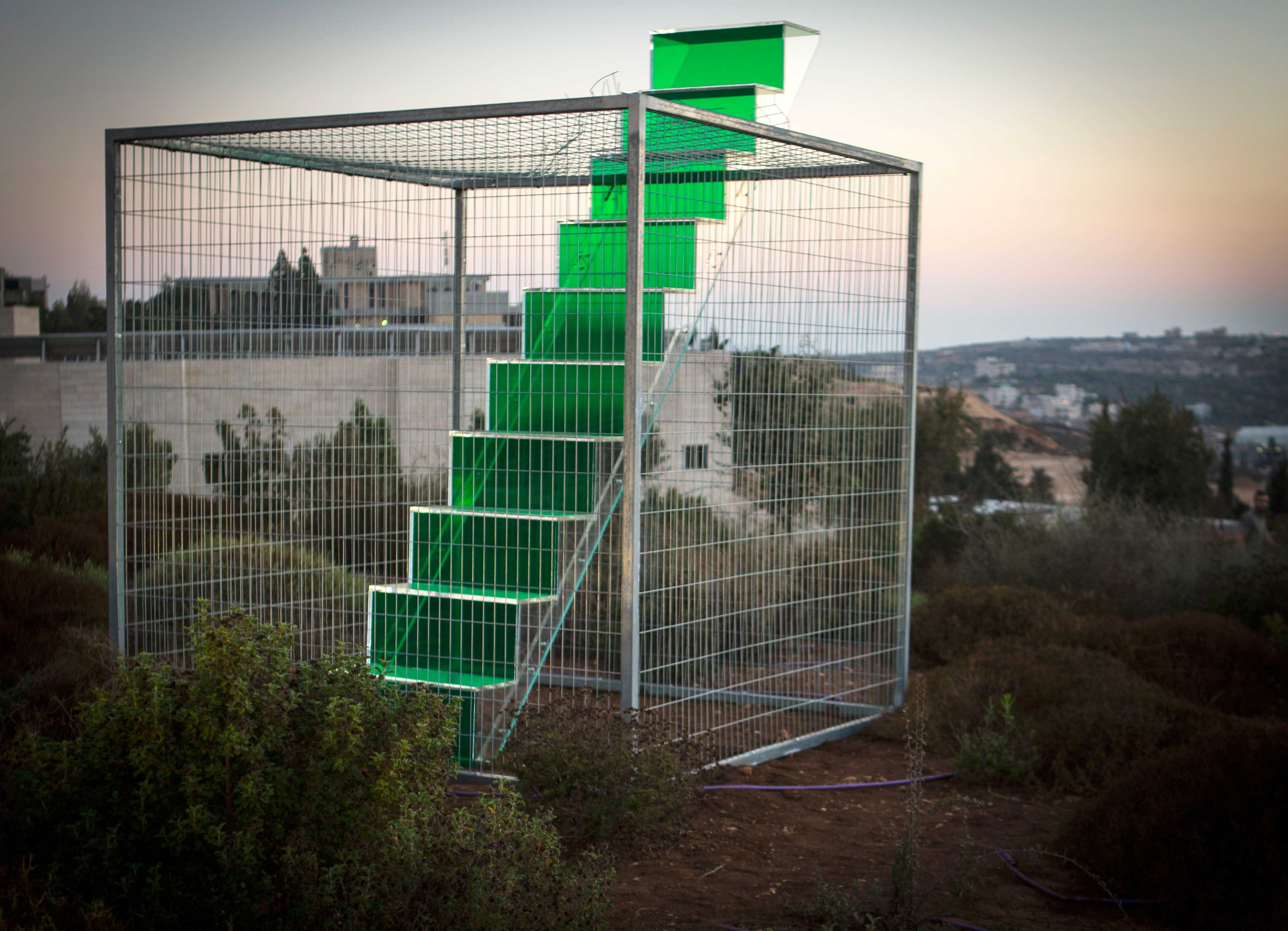
"Home", 2017
Plexiglas, iron, wire screen, 275x275x275 cm.
Vera Tamari: Born 1945, Jerusalem, Palestine. Lives and works in Ramallah.
Vera Tamari is an artist, curator, art historian and educator. Nature and the rich and complex lived history of Palestine are dominant themes in her multidisciplinary artistic practice. Tamari’s works come from the perspective of her personal encounters with the landscape of Palestine, one that is both filled with awe at the complexity of the land, its ancient olive trees, the cacti and the rolling hills, but also the brutal occupation of it. Tamari works with diverse media and has realised artworks in bas-relief imagery from clay, or ambitious public installations using cars that have been wrecked by Israeli incursions. "Home" is an installation deriving from the artist’s own memories and experience. She recalls the staircases of Palestinian homes in the old city of Jerusalem, a space which historically was shared with one’s neighbours and community. Today, these homes and staircases are caged – a “security” measure, enforced by settlers, that besieges Palestinian families in their own homes. In the words of the artist, the work is “Rising up and beyond in defiance of the caged colonisation of Palestinian homes of Jerusalem.”
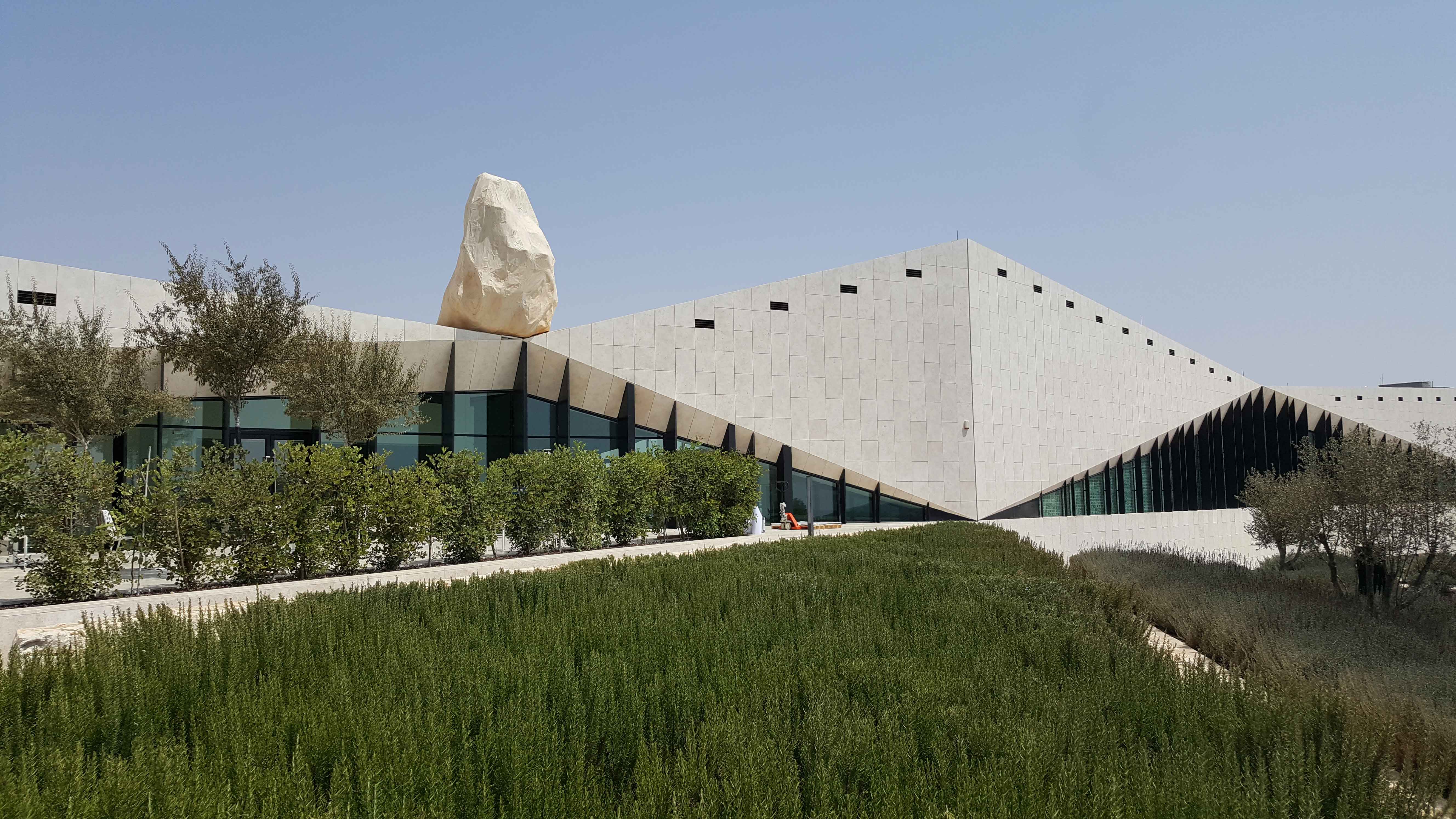
"Falling stone, Flying stone", 2017
Mixed media, 400x400x250 cm.
Yazan Khalili: Born 1981, Damascus, Syria. Lives and works in Ramallah.
Yazan Khalili examines how histories have framed the landscape in Palestine. Working primarily with photography, text and video, Khalili applies critical distance to explore romantic ideas pertaining to territory. In "Falling stone, Flying stone", an enigmatic rock is oddly nestled on the Palestinian Museum’s slanted rooftop, weighted as if causing the dent in its architecture. At night the same rock glows, as if it is light enough to hover in the night sky. With this stone, Khalili stitches together disparate narratives. Jerusalem’s industry thrives on its stone quarries, from which the limestone known as Jerusalem stone, so ubiquitous in the city’s historic and contemporary architecture, is excavated. Islamic tradition recounts the Mi’raj, the ascension of the prophet Muhammad into heaven from a stone at the site of the Al Aqsa mosque. This same stone is also the place from which the angel will sound his trumpet on Resurrection Day, while Judaism speaks of the foundation stone of the world where Abraham prepared to sacrifice Isaac. In contemporary times, rock throwers have become synonymous with the liberation project of Palestine. It is with these narratives that the city of Jerusalem is both elevated by the myth of the stone and weighed down by its burden.

"God Bless", 2017
Light boxes, acrylic, PVC, National paint, LED, light boxes 1850x120 cm.
Inass Yassin. Born 1973, Nablus, Palestine. Lives and works in Ramallah and Main.
Inass Yassin’s multifaceted practice focuses on themes rooted in her personal experience. She examines modernity in the Arab mind through the disappearance of social and cultural networks, exploring this through photography, film and installation, and interrogating the material and immaterial causes of the dissipation of the Arab cultural renaissance. The transformation of spaces and urban gentrification in Ramallah and neighbouring cities such as Beirut and Amman have also been a focus. Yassin’s large-scale paintings, in acrylics and oils, are visceral and immediately felt. The result of a reaction to the overwhelming construction and urbanisation of Ramallah, which has gradually blocked her vision of the horizon and the sea, she marks her surfaces with swathes of paint and intricate detail, evoking dark and tumultuous atmospheres. "God Bless" is a light installation that references social, cultural and traditional sublimations. The light boxes – which state, in Arabic, "Bless this earth whether it is holy or unholy" – beckon a break from indoctrinated thought in order to look at the landscape and oneself in a whole, realistic and unified way.

"Directions", 2017
Marble, dimensions variable.
Sultan bin Fahad: Born 1971, Riyadh, Saudi Arabia. Lives and works in Riyadh.
Sultan bin Fahad works with painting and sculpture. A self-taught artist, bin Fahad’s imposing abstract paintings are made with thick strokes of paint, sand, pearl, mica flakes and powdered glass. Inspired by spirituality as well as the material culture of Mecca in his native Saudi Arabia, this line of inquiry has inspired bin Fahad to imagine his own language for a contemporary yet critical Islamic art. Themes central to his artistic practice revolve around repetition, sound and movement, using symbols that derive from Islam: the five daily prayers, pilgrimage and the Kaaba. Over the last five years, bin Fahad has been collecting discarded archaeological objects from Mecca, and "Directions" is a new work deriving from this collection. The artist sent eight marble prayer compasses appropriated from Mecca to Palestine, in a gesture in which these discarded objects from one holy place find an anchoring in another. The artefacts are relocated and arranged in a circular manner, with a piece of Palestinian marble carved in a compass’s central star shape in turn repurposing the objects to become a compass that points to all directions.
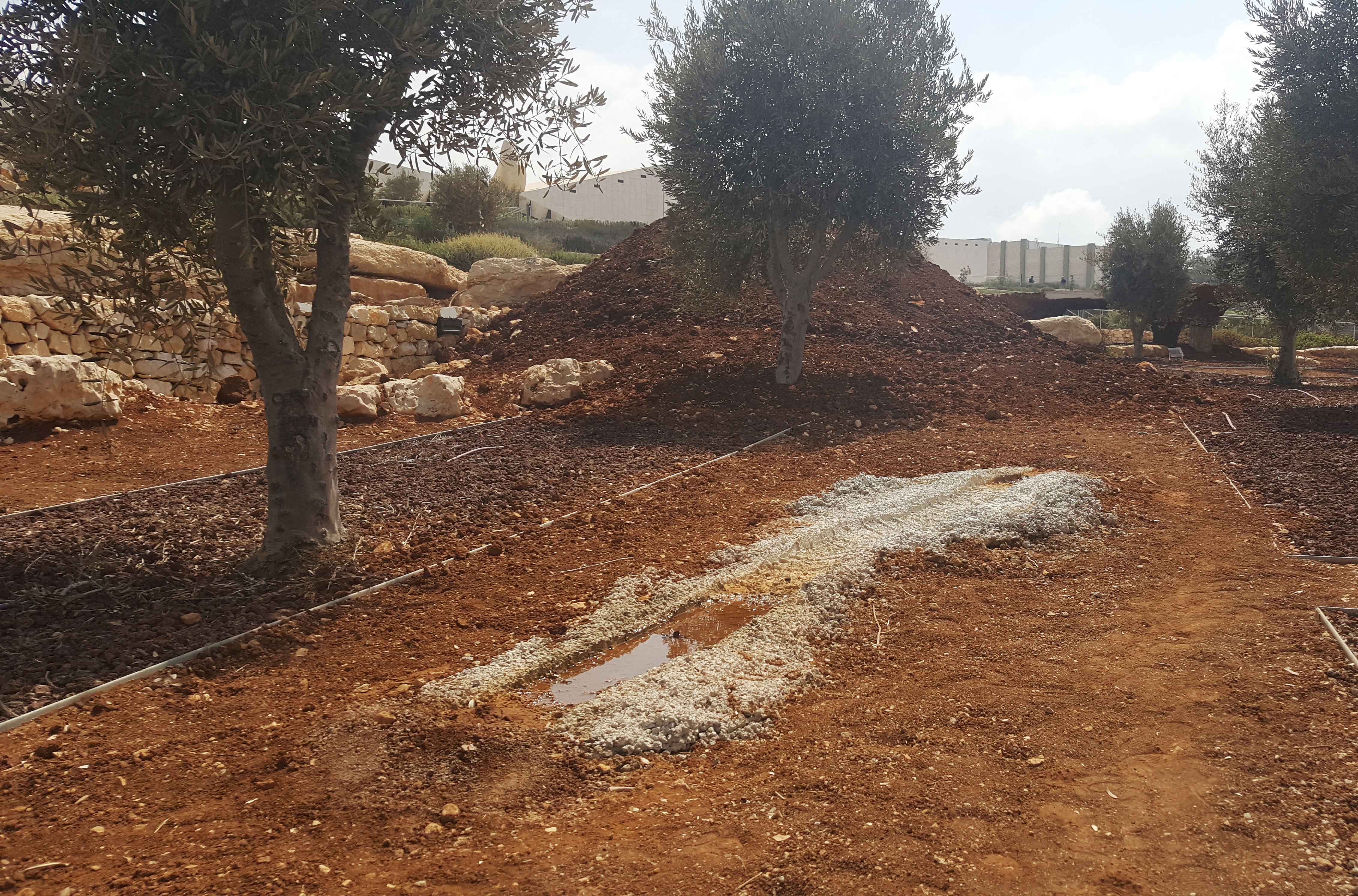
"And Then The Birds Flew Over", 2017
Concrete, soil, water, dimensions variable.
Maria Thereza Alves: Born 1961, São Paulo, Brazil. Lives and works in Berlin.
Maria Thereza Alves’s research-based work unearths silenced histories from different localities. Her relational site-specific projects respond to the immediate physical and social environment, and aim to create spaces of agency and visibility for the oppressed. She mostly focuses on interventions in land and empowers a language for organic growth in opposition to the regimented and controlled. Her long-term project Seeds of Change (2002–ongoing) considers ideas of commerce, ecology, colonialism and migration as she follows the movement of seeds that have been dispersed by cargo ships carrying both passengers and goods. "And Then The Birds Flew Over" is a discrete intervention in the Palestinian Museum composed of a pile of earth, reaching three metres high, and a pond of water. With this simple proposition, Alves has enabled a natural environment to flourish, with new vegetation unexpectedly growing in the otherwise manicured gardens of the Museum. Purposefully placed within the slabs of rocks in the ‘Garden of Resistance’, this soil mound celebrates growth from the otherwise static and inanimate.
* This work is done in cooperation with Khalil Sakakini Cultural Centre, where the artist has an exhibition of past and newly commissioned works on view (16 September - 20 October 2017) curated by Lara Khaldi.